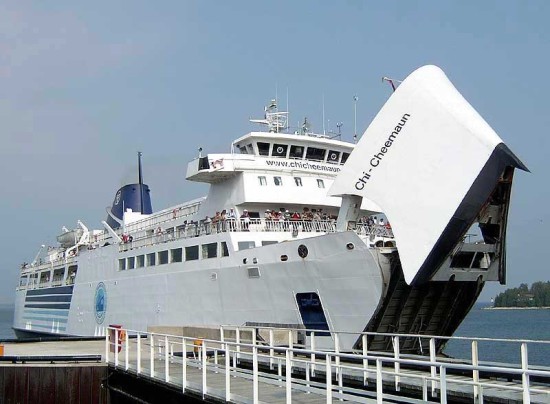If anything puts the lie to the International Joint Commission’s (IJC) “do nothing” option regarding the dropping water level in Lake Huron (and Lake Michigan that shares the same level) it’s the breaking news on Monday of this week that the Chi-Cheemaun is unlikely to be able to begin her sailing schedule, as usual, on the first Friday of May.
That day, May 3 this year, is much anticipated on Manitoulin and doubtless on the North Bruce Peninsula as well because it represents the day that Manitoulin Island is officially back on the tourism map for the current year.
While the low water levels do not precisely prevent the Chi-Cheemaun from entering South Bay, the fact of the dropped water level has meant that the fenders on the South Baymouth ferry dock are no longer effective and need to be lowered to accommodate the ship’s requirements in the new low-water reality.
Of course accommodations like this are mirrored all around Lake Huron and Georgian Bay as many marine-based businesses and communities scramble to stay in business and consider high-cost options such as blasting deeper channels or dredging.
So now, one of Manitoulin Island’s icons, the Chi-Cheemaun can’t dock properly and so the sailing season is delayed until the appropriate remediation is addressed and completed by Transport Canada, the owner of the South Baymouth ferry dock.
The Manitoulin Area Stewardship Council’s (MASC) final response to the “do nothing” option ironically (and also symbolically) shares prime front page real estate in this issue of the paper along with the announcement of the Chi-Cheemaun’s sailing schedule upset.
The MASC group’s response to the IJC’s recommendation that emphasizes letting nature take its own course is emphatic: that this is largely a man-made problem as the unnatural lowering of the St. Clair River, on commercial grounds, has allowed enormous and unnatural volumes of water to spill out from Lake Huron and into Lake Erie and eventually into Lake Ontario and the St. Lawrence River.
The MASC group’s final response to the IJC is, basically, that since the issue is man-made, then also so should the solution, or at least a large part of it, be engineered by people who must immediately be given the authority and resources to do so by the Canadian and US governments and also by the Province of Ontario and the US states that border Lakes Huron and Michigan.
The Chi-Cheemaun dilemma says it all, and very graphically: there is an enormous problem that requires more than a taken response.
Pawning off the problem on future generations (i.e. ‘letting nature take its course’) is not a viable option.





